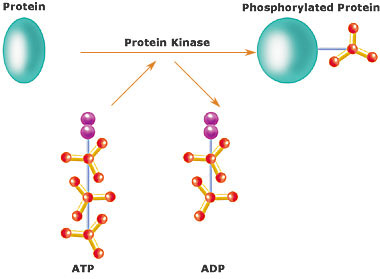Kinases are enzymes responsible for relaying signals in and out of cells, allowing them to respond adaptively to their environment. Kinases influence almost all cellular activities, ranging from proliferation and remodeling to differentiation and programmed cell death. By understanding the basics of kinase-mediated signal transduction, scientists can gain insight into the way cells function in various biological processes both under normal and pathological circumstances. In this blog post, we’ll explore how kinases relate to signal transduction pathways at a basic level so that readers can begin building a foundation for more specialized research
Introducing Kinases and their Role in Cell Signaling
Kinases are essential components in cell signaling processes. These enzymes play a crucial role of catalyzing the transfer of a phosphate group from ATP to a substrate, like proteins. By doing this, they enable signal transduction within cells and throughout the body by modifying key proteins such as enzymes. The process of phosphorylation leads to changes in the substrate protein’s activity. Ultimately, the effect of the kinase is to control a biological function. Protein kinases have an incredible level of diversity due to their varied roles across biology. Often kinases contain domains that are specific to the type of cellular signaling on which they act. Understanding these molecules is key for comprehending how cells navigate between stimulus and response, with kinases representing a crucial checkpoint along this pathway.
What is a Kinase and How Does it Work in the Cell
Kinases are enzymes that help regulate cells of all living organisms by controlling signal transduction pathways. In essence, they act as a catalyst to “switch on/off” various cellular functions including metabolism and growth. One of the main ways they do this is by catalyzing phosphorylation – the addition of a phosphate group to proteins – using ATP molecules. This process allows for communication between molecules, creating the signaling cascades needed for cell processes and maintenance. There are over 500 protein kinase genes in humans with different functions, revealing their importance in cellular signaling.
Types of Kinases and Their Specific Functions
Kinases are a group of enzymes that transfer phosphate groups from high-energy, donor molecules to specific target molecules, modulating their function. These enzymes play an important role in numerous biological processes, including cell cycle regulation, metabolic activity and signal transduction. Kinases come in a variety of forms and sizes, each with its own distinct function. For example, phosphorylase kinase is integral for glycogen metabolism, while protein kinase A has been identified as the main regulator of cyclic AMP levels. Another important group of kinases include tyrosine kinases, which functions in signal transduction pathways; calcium/calmodulin-dependent protein kinase involved in neuronal regulation; and myosin light chain kinase involved cellular structure movement. In recent years, research has focused on the role these enzymes can play in drug therapy for conditions such as cancer and autoimmune diseases.
How Kinases are Regulated to Control Cellular Processes
Kinases are proteins that are responsible for catalyzing the transfer of phosphate groups from high-energy donor molecules to other biomolecules, including a number of proteins. This transfer is necessary for many cellular processes. Without appropriate kinase regulation, the cell would be unable to respond efficiently to local demands. Therefore, it is critical to understand how these enzymes are regulated in order to ensure proper functioning throughout the cell. Several mechanisms are used for kinetic regulation, such as allosteric control, post-translational modification, and compartmentalization. Allosteric control occurs through ligand binding and involves reversible conformational changes that can cause an enzyme’s active site to become less or more accessible depending on certain conditions within the cell. Post-translational modifications can also alter enzyme activity by covalently modifying its structure; this technique typically involves protein phosphorylation and dephosphorylation events, which use kinases and phosphatases, respectively. Lastly, compartmentalization limits substrate availability, thereby controlling a kinase’s activity when necessary. Taken together, these techniques employ sophisticated feedback systems that enable cells to exquisitely regulate their biochemical processes in an effective manner
Kinase Inhibitors and How They Affect Signaling Pathways
Kinase inhibitors are becoming increasingly popular in pharmacological treatments as they provide a way to positively modulate cellular signaling pathways, thereby regulating cell functions. They work by blocking the activity of the target kinases resulting in reduced functionality of that enzyme. Kinase inhibitors represent an effective and reliable method of preventing diseases such as certain types of cancer. Further research has also allowed researchers to target their kinetic inhibitors with greater precision to specific types of cells and signaling pathways, allowing for more directed therapeutic applications. As advances in molecular biology increase our understanding of how these enzymes work in disease processes, it is likely that we will continue to rely on kinetic inhibitors as an important tool for improving therapies.
Key Applications of Kinases in Clinical Research
Kinases play a powerful role in modern clinical research and are being used to support healthcare professionals in the fight against life-altering diseases such as Alzheimer’s, and Cancer. One of the most important applications of kinases is in the diagnosis of breast cancer. HER2 kinase can be used to identify women who are at the highest risk of developing aggressive forms of disease. In addition, other kinase families, such as those that make up the Diacylglycerol Kinase (DGK) family, have been studied for their potential applications in clinical research. Studies have suggested that inhibitors of these enzymes may be useful for therapeutic interventions involving certain tumor types and may even offer benefits such as improved survival rates. With more research into the use of kinases in clinical contexts, advancements towards better treatments for cancer and other debilitating illnesses can only increase.
Kinases are one of the most important signaling molecules in our cells and are involved in numerous crucial processes such as growth, metabolism, immune response, development, apoptosis and cell differentiation. Kinases have many specific functions and can be regulated through kinase inhibitors to control various cellular pathways. Their importance as regulators of gene expression and protein activities have been used in various clinical studies which have helped develop medications and treatments for a variety of diseases. Although they are complex molecules with intricate biological functions, it is possible to understand their roles in physiology by studying them more closely. From understanding these essential proteins more thoroughly, scientists are beginning to uncover the fascinating contribution that they make to maintaining life processes. It is clear that further research into kinases will continue to provide insight into their molecular mechanisms thereby aiding our journey towards better health for all. With this information presented about Kinases, what are your thoughts on them?


